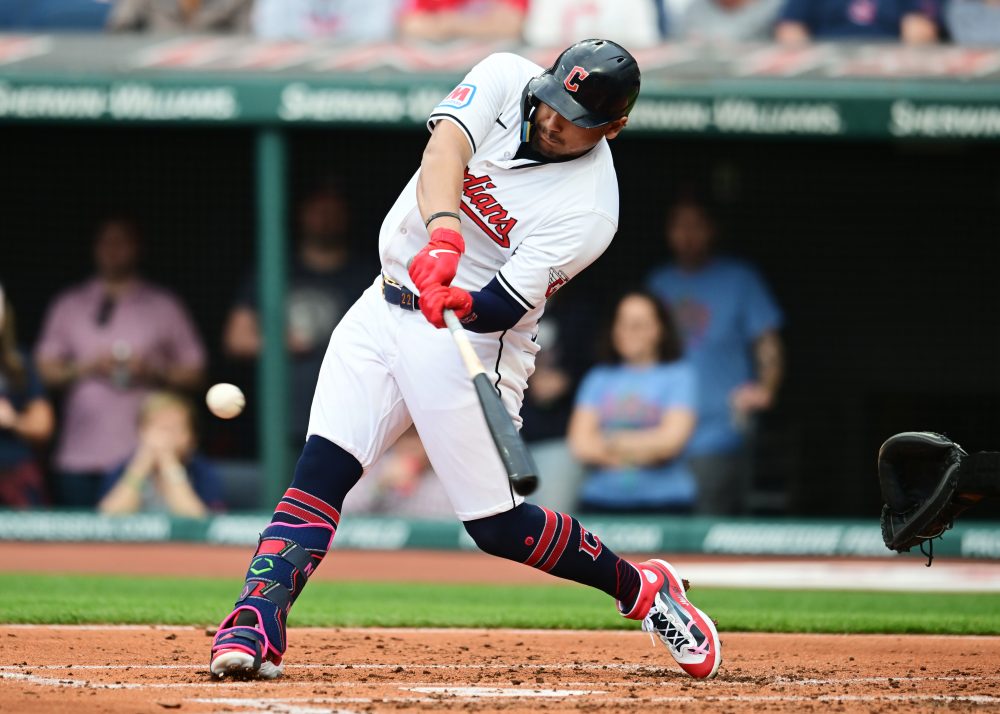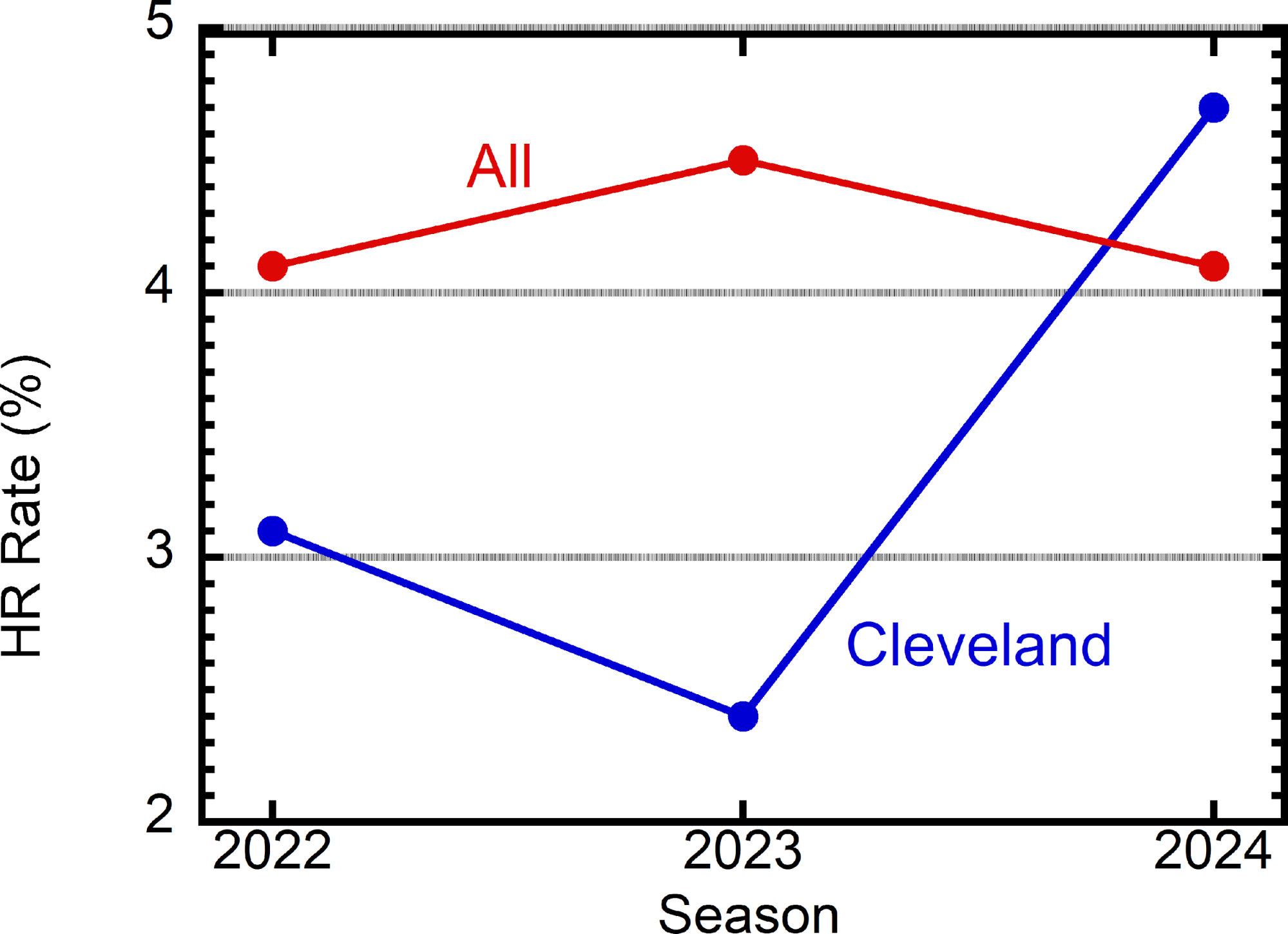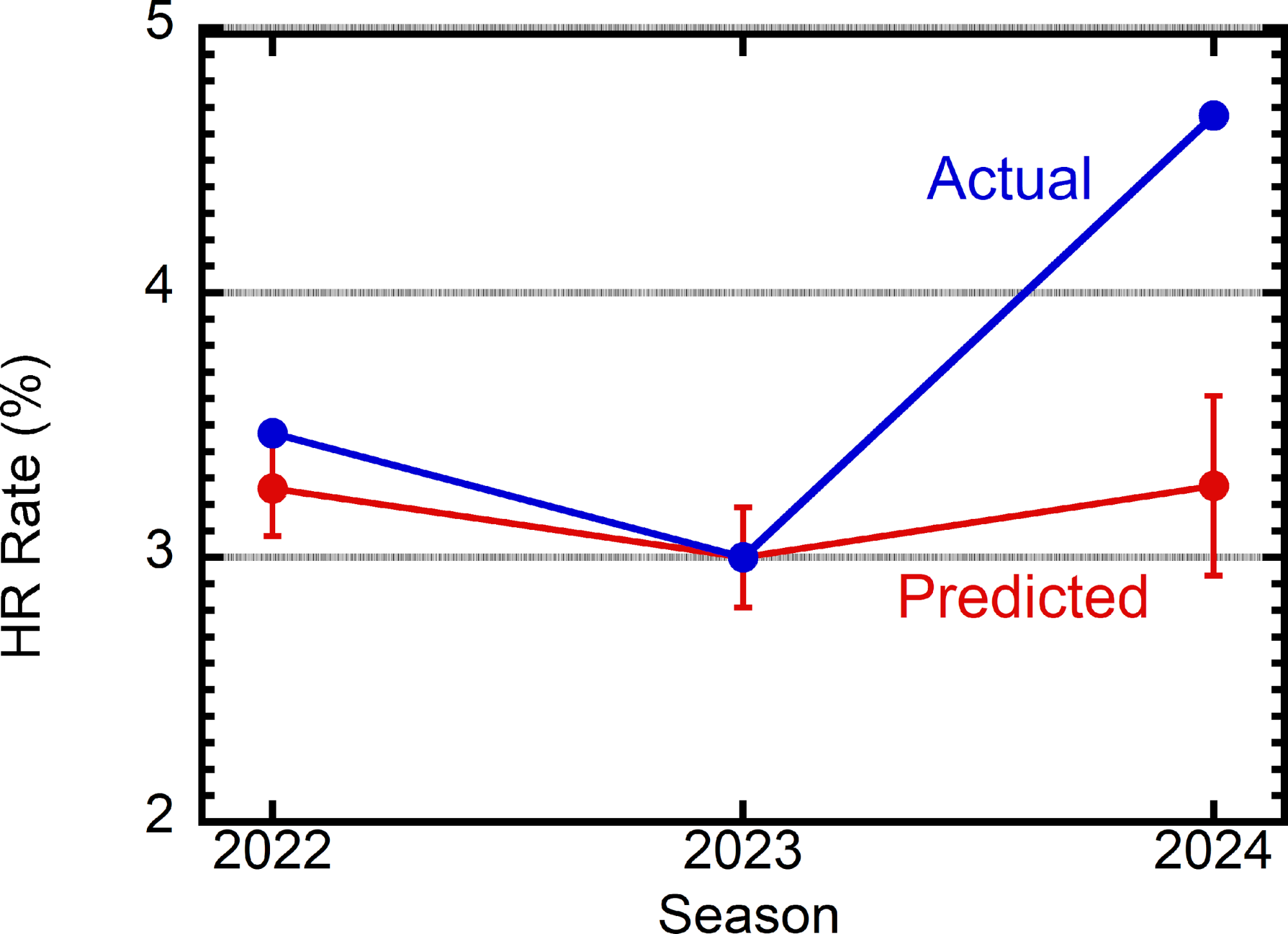
Picture credit score: © Ken Blaze-USA TODAY Sports activities
A really fascinating story was revealed on-line on June 10, entitled “Have Progressive Area upgrades created a house run ‘wind tunnel’?”. The article talks about modifications made to Progressive Area over the last offseason and the way these modifications would be the purpose for the sharp enhance in house runs in Cleveland this yr. There’s hypothesis that the modifications to the outfield stands in each proper and left subject could result in stronger out-blowing wind currents that propel fly balls additional, leading to extra house runs. The creator, Joe Noga, had contacted considered one of us per week or so earlier to ask whether or not the “wind tunnel” speculation is legitimate. In the event you look in direction of the top of the Noga article, you will notice the account of that interview. Not having been conscious of the difficulty previous to then, one of the best lets say was that such a concept is believable within the following sense: Modifications to the stadium construction might result in modifications in wind currents, and people modifications in wind currents might result in extra house runs. We emphasised that whereas the idea is believable, to show or disprove it could require some critical evaluation. What adopted was our try at critical evaluation, which we report on on this article.
As a place to begin, it’s helpful to doc the modifications in house run charges on balls in play over the previous a number of years, that are documented in Fig. 1. Whereas the charges for all MLB parks stayed pretty fixed in the course of the interval 2022-2024, there’s a putting leap within the fee in Cleveland in 2024. Presumably it’s that enhance that has brought on hypothesis in regards to the wind-tunnel concept.

FIG. 1. Residence runs per ball-in-play for Cleveland and for all MLB parks, from the beginning of every season by June 15.
The issue with merely taking a look at house run totals is that there’s all the time the argument that the Guardian batters are merely higher this yr. They’re hitting the ball tougher, maybe extra typically and at a extra optimum launch angle, leading to extra house runs. To exclude that chance requires a distinct strategy.
The evaluation we current right here is designed to extra immediately deal with the wind tunnel speculation by investigating the “carry” of a baseball. By “carry” we imply the gap the fly ball travels for given launch parameters. It makes no distinction how the batter achieved these launch parameters or whether or not José Ramírez has considerably improved his batting this yr. We’re solely taking a look at what occurs to the ball as soon as it leaves the bat. If there may be an out-blowing wind, it is going to journey farther, leading to extra house runs; if an in-blowing wind, it is going to journey much less far, leading to fewer house runs.
Our plan of assault is to make use of publicly accessible Statcast knowledge to analyze the carry of a fly ball by taking a look at each fly ball distances and residential run charges for mounted launch situations. Relating to the wind tunnel speculation, what can be most related is whether or not there may be proof for improved carry at Progressive Area in 2024 relative to the earlier two seasons. If there is a rise in distances and/or house runs, which means the ball carries higher and helps–however doesn’t essentially show (extra on this later)–the wind tunnel speculation, unbiased of the standard of the batters.
We first have to ask what are the launch parameters that decide fly ball distances. This specific query was addressed by considered one of us in an unpublished article from a couple of years in the past, the place it was discovered that there are 4 related launch parameters: exit velocity, launch angle, spin fee (i.e., rpm), and spin axis, the place the latter determines the proportions of the spin which can be backspin and sidespin.
We first examine house run charges utilizing a method similar to the one we used two years in the past and described on this article. We use video games from all MLB parks aside from Progressive Area as our reference knowledge, to which we match a generalized additive mannequin (GAM) for every season individually. The GAM relates the likelihood of a house run to a clean operate of the launch parameters. Ideally, all of the related launch parameters can be used. Sadly, that’s considerably problematic, because the batted ball spin fee and spin axis usually are not publicly accessible. Accordingly, for this evaluation, we use solely exit velocity and launch angle, along with game-time temperature, which might have an necessary impact on house run likelihood.
Having fitted a mannequin based mostly on the opposite parks, we then apply that mannequin to the Progressive Area knowledge to foretell a house run likelihood based mostly on the launch variables for every ball in play. Summing all these chances, we arrive at a predicted house run complete, from which we discover a predicted house run fee. This prediction might be in contrast immediately with the precise house run fee. If the carry of a fly ball have been the identical in Cleveland as in the remainder of the parks, the expected fee can be near the precise fee. The comparability is proven in Fig. 2. For 2022 and 2023, the expected and precise charges are fairly shut. Nevertheless, in 2024 the precise house run fee exceeds the expected fee, displaying that the fly ball carry in Cleveland in the course of the present season is considerably higher than elsewhere. The anticipated variety of house runs for 2024 is 52, whereas the precise quantity is 68, a rise of 30%.

FIG. 2. Predicted and precise house run charges for Progressive Area, based mostly on a generalized additive mannequin fitted to knowledge from the opposite MLB parks. The vertical bars are normal errors.
We subsequent flip to fly ball distances. An evaluation just like that simply described for house runs can be utilized to fly ball distances. The important thought is similar: We ask whether or not fly ball distances in 2024 are totally different from these in 2022 or 2023, assuming similar launch situations. We might examine this query for a complete vary of various launch situations, however for the sake of simplicity we’ll confine ourselves to these launch situations resulting in the most important distances. These are launch angles within the vary 25-30 levels and exit velocities within the vary 90-110 mph. For these “home-run-friendly” launch situations, the fly ball distance relies upon linearly on exit velocity, as proven in Fig. 3, with a slope of about 5 ft/mph. Observe that there’s appreciable scatter of the factors in regards to the linear match, a function we’ll return to shortly.
Guided by these concerns, we carry out a linear match of distance with inputs exit velocity, season (2022, 2023, 2024), and game-time temperature. We assume a standard slope for each exit velocity and temperature for the three seasons and totally different season- dependent intercepts. Estimates for the difference-in-seasons impact are displayed in Desk I, the place we discover that fly balls in Cleveland in our home-run-friendly vary of exit velocities and launch angles traveled 8.0±2.4 and 12.9±2.9 ft farther in 2024 than in 2023 and 2022, respectively. We then did an similar evaluation for each MLB stadium, with the outcomes additionally proven in Desk I and in Fig. 4. The latter clearly exhibits that Cleveland is an outlier.

FIG. 3. Distance vs. exit velocity for launch angles within the vary 250 − 300, with the crimson line being a linear match with slope 5.6 ft/mph. The info are from the 2023 season.
TABLE I. Estimates of the difference-in-seasons impact in fly ball distance (∆) and normal errors (err) between seasons 2024 and both 2023 or 2022 for balls hit in Cleveland and in all of MLB. The info are for launch angles within the vary 250 − 300 and for exit velocities within the vary 90-110 mph. The z values are the ratio of ∆ to err.
Cleveland
All
Seasons
∆ ± err
(ft)
z
∆ ± err
(ft)
z
2024-2023
2024-2022
8.05 ± 2.43
12.87 ± 2.52
3.31
5.11
-1.87 ± 2.42
-0.31 ± 2.47
-0.76
-0.12

FIG. 4. Plot of z values for every MLB venue, the place z represents the ratio of the estimate of the difference-in-seasons impact divided by the usual error from the regression mannequin relating distance with exit velocity, season, and temperature. The crimson line is the MLB common and the crimson dot highlights Cleveland.
The previous analyses for each house run charges and distances of home-run-friendly fly balls present that the carry in Cleveland has elevated considerably in 2024 relative to the previous two seasons and relative to the remainder of the league. That was our authentic aim. Nevertheless, you will need to be aware the appreciable scatter–about 19 ft root-mean-square–of the factors in regards to the linear slot in Fig. 3, suggesting that there are extra components affecting carry which weren’t taken into consideration in our becoming. One such issue is wind. Nevertheless, it’s untimely to conclude that wind is the first issue since, as already famous above, each spin fee and spin axis additionally play an necessary position within the carry of a fly ball. Variation in these spin parameters throughout seasons and/or throughout MLB parks can’t be dominated out as a purpose for the change in carry in Cleveland in 2024. So whereas we can’t rule out the wind tunnel speculation, we can’t verify it both. Hopefully the new applied sciences that decide wind pace and route in MLB parks will shed new gentle on the topic.
Jim Albert is Emeritus Professor, Division of Arithmetic and Statistics, Bowling Inexperienced State College.
Alan M. Nathan is Professor Emeritus of Physics on the College of Illinois, Urbana-Champaign.
Thanks for studying
It is a free article. In the event you loved it, think about subscribing to Baseball Prospectus. Subscriptions help ongoing public baseball analysis and evaluation in an more and more proprietary setting.
Subscribe now
















